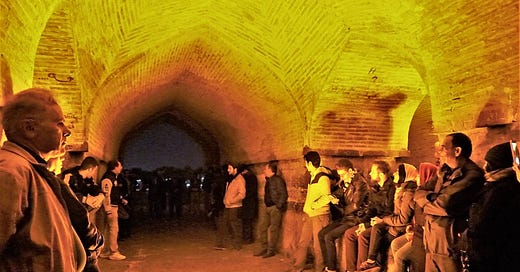#23 Whispering bridges, Detector Locks and umbrellas
It’s Design Lobster #23. This week we’re looking at bridges that help you flirt, and fancy locks that will tell you if anyone has been snooping on your stuff. Let’s go through the keyhole. 🚪
Question: How can courtship happen in a segregated society?
The Khaju Bridge was built across the Zayandeh river in Esfahan, Iran in the early 17th century at the order of Shah Abbas II. Besides carrying traffic, the bridge functioned as a weir allowing the water level to be controlled for royal entertainments and a teahouse at its midpoint was a popular destination for Esfahani society. Though the river is now dry for most of the year, the cool arches underneath the roadway are still a popular meeting spot, not least because their acoustics amplify singing wonderfully.
But not only singing is amplified, it’s also possible to whisper in one corner of an arch and be heard startlingly well at the opposite one. It’s not clear whether the original designers intended this effect but in post-revolutionary Iran, where it is difficult for young unmarried men and women to mingle, the phenomenon has facilitated much teenage courtship. If you visit, you can observe groups of teenage boys huddling in one corner and teenage girls in the other—each group occasionally bursting out in raucous giggles at what they had heard. Any patrolling religious policemen can do little, since technically the rules of segregation are being observed.
I think this is a nice example of a piece of design evolving to solve new problems in a changed context. Once a piece of design is put into the world it will always take on a life of it’s own – something I think we should celebrate and encourage.
Design takeaway: How might your design evolve and change once you release it into the world? And can you bear to let it go?
MUCH more about the acoustics of arches and domes here. 🗣
Object: Detector Lock
I discovered this fabulous lock in the Victoria & Albert Museum Archives. It was designed in approximately 1680 by John Wilkes, a Birmingham locksmith, and contains all kinds of mechanical features to protect the contents of the closet to which it was fitted.
First, a user must push a secret button to swing forward the leg of the figure and reveal the keyhole. Then they must tilt the hat to release the bolt. Every time the key is turned the dial on the right moves around and the figure’s staff points at the current number. The owner need only memorise this number and check it is the same the next time he opens the lock to be sure that no-one else has been snooping in between.
I think the Detector Lock is an amazing marriage of technical skill and whimsical charm. I don’t think I’ve ever seen a lock that carries out it’s functions with so much personality. An inspiration for all of us trying to make useful and delightful things.
I leave you with stern words of warning from the man with the hat and staff:
If I had ye gift of tongue
I would declare and do no wrong
Who ye are ye come by stealth
To impare my Master's wealth.
Design takeaway: How could your design carry out its job with more personality?
More John Wilkes lock porn here. 🗝
Quote: “The mind is like an umbrella, it’s most useful when open.”
– Walter Gropius, Founder of the Bauhaus
Walter Gropius was one of the leading Modernist architects and founded the Bauhaus in 1919. I picture him declaiming this pithy quote to first-year students in one of the glass and steel ateliers of the Bauhaus complex in Dessau. It’s a reminder to stay receptive to new information and ways of thinking. When we close our minds down, then our designs suffer.
Keep discovering. 🦞
Has this email been forwarded? Sign up below to get the weekly emails delivered to you. ✏️





